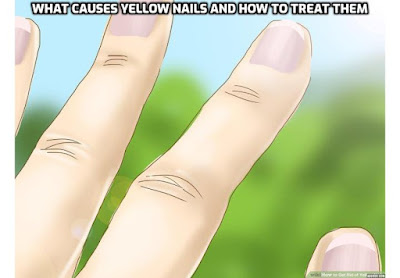CLICK on HERE to find out how you can get perfect nails and skin
Understanding Yellow Nails: Causes, Symptoms, and Treatment
Introduction
Yellow nails can be a concerning condition that affects both fingernails and toenails.
The discoloration can be caused by various factors, ranging from lifestyle habits to underlying health issues.
In this post, we will explore the causes of yellow nails, discuss common symptoms, and provide insights into available treatment options.
1. Fungal Infections
Causes: The most common cause of yellow nails is a fungal infection, known as onychomycosis. Fungal organisms thrive in warm, moist environments, making the nails susceptible to infection. The infection can result in discoloration, thickening, and brittle nails.
Symptoms: In addition to yellowing, fungal nail infections may cause changes in nail texture, such as brittleness, crumbling, or thickening. You may also experience nail separation from the nail bed and a foul odor.
Treatment: Treatment options for fungal nail infections include topical antifungal medications, oral antifungal drugs, or a combination of both. It is important to follow the prescribed treatment regimen consistently and practice good nail hygiene to achieve successful resolution of the infection.
2. Nail Polish Stains
Causes: Frequent use of dark or pigmented nail polish without a base coat can lead to yellowing of the nails. The pigments in the polish can penetrate the nail plate, resulting in discoloration.
Symptoms: Discoloration and yellowing of the nails are the primary symptoms of nail polish stains. The nails may appear yellow or stained, especially after prolonged use of dark-colored polishes.
Treatment: To prevent nail polish stains, always use a clear base coat before applying colored nail polish. Additionally, allow your nails to breathe and rest between polish applications. Gentle buffing of the nails can help remove surface stains.
3. Smoking
Causes: Smoking tobacco can stain the nails and cause them to turn yellow over time. The chemicals and tar in cigarettes can discolor the nails and affect their overall appearance.
Symptoms: Yellowing of the nails is a common symptom associated with smoking. The extent of discoloration may vary depending on the frequency and duration of smoking.
Treatment: The most effective way to prevent yellowing of the nails due to smoking is to quit smoking altogether. With time and smoking cessation, the nails may gradually regain their natural color.
4. Underlying Health Conditions
Yellow nails can also be a manifestation of certain underlying health conditions, including:
Nail Psoriasis: Psoriasis, an autoimmune condition, can affect the nails and cause yellowing, pitting, thickening, and nail plate separation.
Thyroid Disorders: Certain thyroid conditions can lead to changes in nail health, including yellowing and thickening.
Lung Diseases: Chronic lung diseases, such as chronic obstructive pulmonary disease (COPD), can cause yellowing of the nails due to decreased oxygen levels in the body.
Watch this video – Onychogryphosis (Thickened, Yellow Nails) | Causes, Signs & Symptoms, Diagnosis, Treatment
Conclusion
Yellow nails can be caused by various factors, including fungal infections, nail polish stains, smoking, and underlying health conditions. Identifying the underlying cause is important in determining the appropriate treatment approach.
If you notice persistent yellowing or other concerning symptoms, it is advisable to consult a healthcare professional for a proper diagnosis and personalized treatment plan.
Maintaining good nail hygiene, avoiding prolonged use of dark-colored nail polish, quitting smoking, and managing underlying health conditions can help prevent and improve yellow nails. Remember to be patient, as it may take time for the nails to regain their natural color and health.
Author Bio:
The reason why antifungals don’t work very well is because the fungus is mutating very fast due to how powerful the treatments we throw at it are.
Kerassentials is a unique blend that fungus has never been exposed to, killing it off for good and getting rid of any spores that might remain behind.
Kerassentials is an extremely potent combination of oils and skin supporting vitamins that you can apply every day after you shower to give your nail bed the boost it needs.
Ingredients – Lavender Oil, Lemongrass Oil, Aloe Vera Gel, Isopropyl Palmitate, DL-alpha-Tocopherol, Organic Flaxseed Oil, Tea Tree Oil, Almond Oil, Clove Bud Oil, Undecylenic Acid, and Manuka oil
These carefully selected ingredients will give your skin the support it needs to constantly rebuild itself and stay healthy. Kerassentials is the only complete formula that maintains the health of your nails in multiple ways.
The result
Perfect nails and skin, with the bad smell and itching completely gone forever!
When can I see results?
I know you are excited to finally rid this annoying fungus, so I can tell that you start noticing improvements immediately. Because your toenails will look more alive. The itchiness will be soothed. And within the first weeks you should be noticing new healthy pink nails growing out to replace the damaged areas. But I can tell you the biggest change will be in your confidence seeing yourself finally beat this thing that has been haunting you for so long.
To find out more about Kerassentials, click on Getting Perfect Nails




